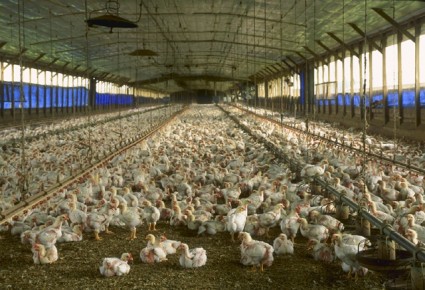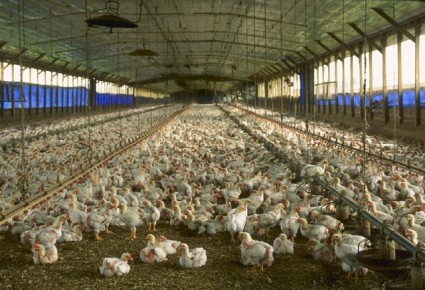 No visitors allowed on chicken “farms” like these, says the FDA Customers of Country Hen, a central Massachusetts organic egg producer, found an upsetting announcement in their egg cartons recently: The farm tours that had been a tradition of the farm since it opened 22 years ago were being discontinued.
No visitors allowed on chicken “farms” like these, says the FDA Customers of Country Hen, a central Massachusetts organic egg producer, found an upsetting announcement in their egg cartons recently: The farm tours that had been a tradition of the farm since it opened 22 years ago were being discontinued.
The reason? A new federal law that went into effect last month called the “Egg Safety Final Rule,” or 74 FR 33030, which is designed to reduce the risk of a major form of contamination known as Salmonella enteritidis, or SE. The law requires farms with more than 3,000 hens not only to adhere to tight refrigeration protocols, create a disease protection plan, and abide by strict sanitation practices, but also to keep customers out of the chicken houses.
As in much of farming, a small number of large farms produce the bulk of the food. Though just 4,000 farms are above the 3,000-hen cutoff, they account for 99 percent of egg production, and another 65,000 produce the remaining 1 percent or so of egg production, the FDA estimates. It’s these smaller farms, like Joel Salatin’s well-known Virginia farm Polyface, where chickens often wander outdoors, eating bugs and grass, that we tend to picture in our imaginations. Many of these farms have intentionally kept their flocks under the 3,000 cutoff point to avoid the strict FDA rules.
The big farms tend to be the factory operations, out of public sight, where thousands of chickens may be crammed into dark henhouses. But Country Hen, as an organic operation that emphasizes humane treatment of its chickens, tries to project itself as more like one of the smaller operations, with everything open and available for viewing.
Writes George Bass, the owner of Country Hen, on the farm’s Facebook page: “The most difficult change that we had to make because of (the new rule) is such a deep rooted part of our corporate culture, is no more tours of the farm. The biosecurity part of the new law addresses strictly limiting the number of visitors on the farm property and into the barns. Since we opened in 1988, our farm has always been open for customers or potential customers to stop by for a tour.”
And indeed, a review of the lengthy new egg rules by the U.S. Food and Drug Administration contains this requirement for poultry farms: “Use a biosecurity program, meaning a program that includes limiting visitors on the farm and in poultry houses.”
Not surprisingly, customers aren’t pleased. One who was upset sent me a copy of the announcement from her egg carton. Another, Ken West, said on Country Hen’s Facebook page, “I was dismayed to read in your latest issue about the new FDA ‘Egg Safety Final Rule’ which effectively prohibits farm tours by the general public.”
The supposition seems to be that visitors will somehow contaminate the chickens. How does that work? The most obvious danger would appear to be visitors who have previously been at a contaminated farm, who could carry pathogens to a clean farm. (Though I’m not sure how many consumers interested in touring a poultry farm would go from farm to farm.)
But a reading of the FDA rule says that’s not necessarily the problem. In fact, the FDA practically admits it isn’t sure exactly what the problem is. It says in the new rules that while “environmental contamination,” whereby eggs “become contaminated with any microorganism that might be excreted by a laying hen or through contact with … human beings, and other animals may be a source of contamination … SE experts now believe that the predominant route through which eggs become contaminated with SE is the transovarian route.”
So, “although the mechanism is still not well understood” whereby chickens get the Salmonella in their ovaries, visitors must be kept off the farm. Got that? FDA never does explain the logic.
Why should anyone care about this? Because we have a growing disconnect between food consumers and producers. That’s why the movies Food, Inc. and Fresh generated so much interest — many urbanites were shocked to see cattle standing in their manure in feedlots, and chickens crammed into darkened sheds. Indeed, the producers of both films indicated they encountered resistance in gaining access to factory farms to do their filming.
Such films, along with well-publicized abuses at at slaughterhouses and the deluge of new books about the problems of our food system over the last few years, have sparked growing consumer interest in how farms go about producing our food. More consumers have been sending checks to small farms to obtain veggies and meat via Community Supported Agriculture (CSA) programs, or stopping by to pick up raw milk in the more than 20 states where it’s sold direct from farms. The USDA has also been promoting its “Know Your Farmer, Know Your Food” initiative, which cheerfully suggests, “Every Family Needs a Farmer … Do You Know Yours?”
In this climate, it seems odd that the FDA would seek to restrict public access to all the poultry farms that produce 99 percent of the eggs in this country, simply to satisfy some vague notion of “biosecurity.”
Country Hen says it will seek to counter the farm-tour prohibition by publishing more photos of its operations on its Facebook page. But let’s face it, that’s a poor option for letting people know about life on a farm. After all, our large breweries, wineries, and ice-cream makers offer tours and taste tests. Why can’t poultry farms, if they choose, show the public whether their chickens are truly free range or simply allowed an hour or two in the yard outside a shed?
Could it be that government regulators, in their great wisdom, would rather push people to formulate their visions of food production by visiting quaint small farms, those with fewer than 3,000 birds, and not have these visions muddied by the shocks of real life on factory-type farms where most food is produced?



